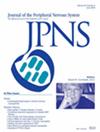Successful autologous hematopoietic stem cell transplantation in a refractory anti-Caspr1 antibody nodopathy
Abstract
Aim
Autoimmune nodopathies have specific clinicopathologic features, antibodies directed against nodal proteins (neurofascin 186) or paranodal proteins (neurofascin 155, contactin 1, contactin-associated protein 1 (Caspr1)), and usually have a poor response to first-line therapies for chronic inflammatory demyelinating polyradiculoneuropathy. Anti-Caspr1 nodopathy treated with autologous hematopoietic stem cell transplantation (AHSCT) has not been previously reported.
Methods
We report the first case of an anti-Caspr1 antibody-positive nodopathy refractory to high-intensity immunosuppressive treatment, including rituximab, that responded dramatically to AHSCT.
Results
A 53-year-old woman presented with a rapidly progressive generalized ataxic, painful motor, and inflammatory neuropathy supported by neurophysiologic and MRI studies. Initial tests for antibodies to nodal/paranodal proteins were negative. She was treated with multiple courses of intravenous immunoglobulin and methylprednisolone, plasma exchange, rituximab, and cyclophosphamide without significant clinical benefit. Repeated testing for antibodies to nodal/paranodal proteins yielded a positive result for anti-Caspr1/IgG4 isotype antibodies. Given the poor response to multiple high intensity treatments and the relatively young age of the patient, we decided to perform AHSCT at 30 months post-onset. Immediately after AHSCT, she stopped all immunomodulatory or immunosuppressive therapy. The Overall Neuropathy Limitation Score improved from 8/12 to 4/12 at 6 months post-AHSCT. At 3 months post-AHSCT, IgG4 against Caspr1 was negative and no reactivity against paranodes could be detected.
Conclusion
We report a particularly severe anti-Caspr1 antibody autoimmune nodopathy that responded dramatically to AHSCT. Although the rarity of the disease limits the possibility of larger studies, AHSCT may be a valuable therapy in treatment-refractory cases.

 求助内容:
求助内容: 应助结果提醒方式:
应助结果提醒方式:


